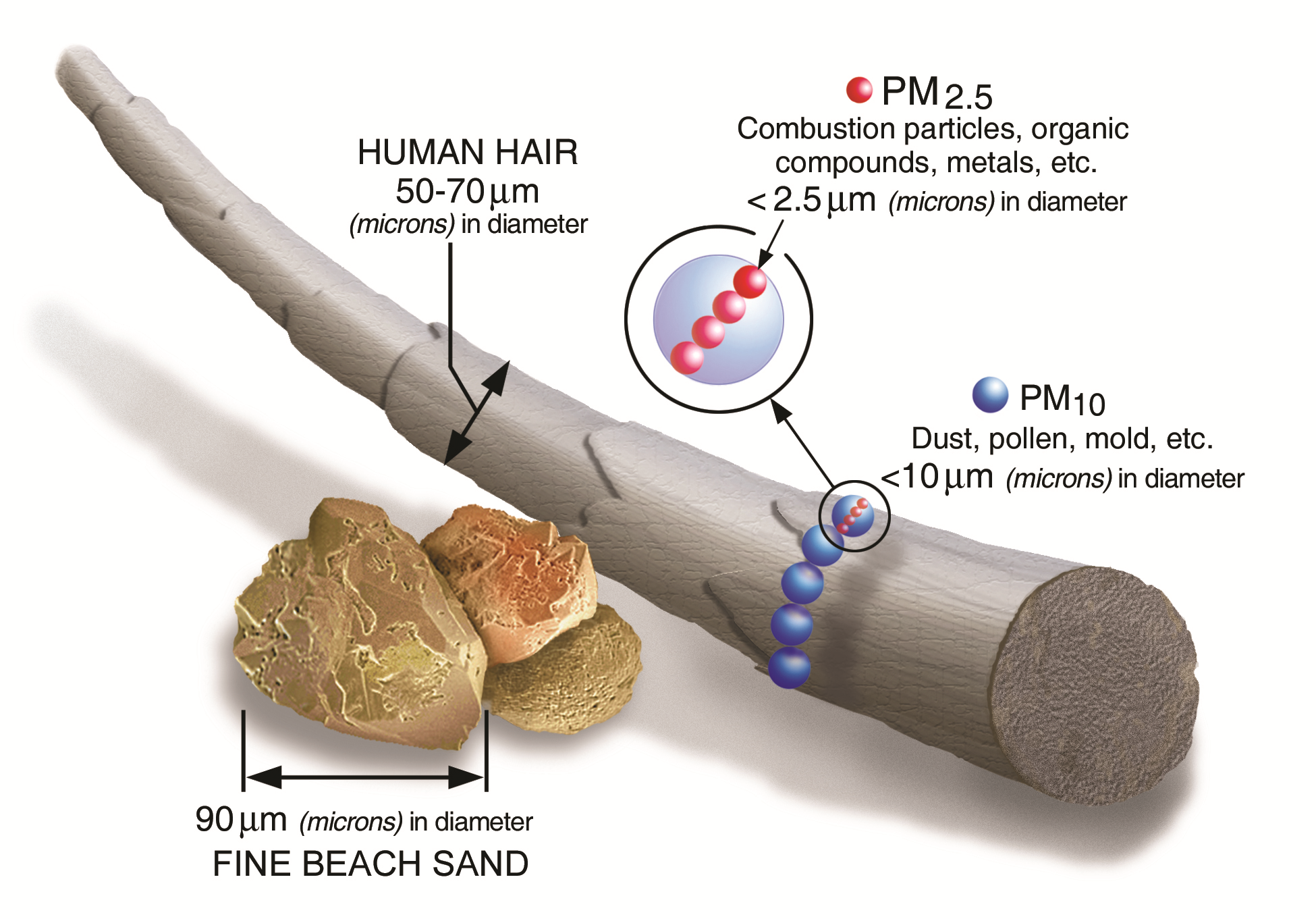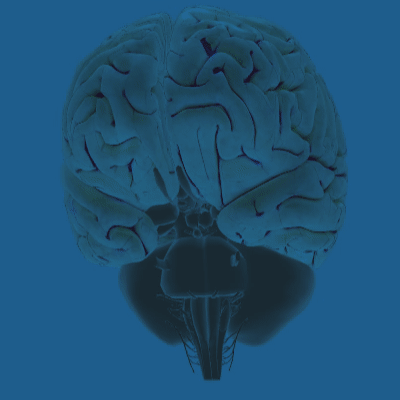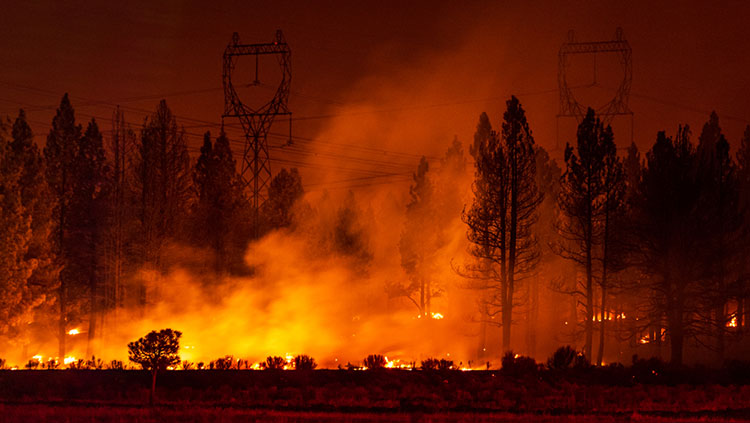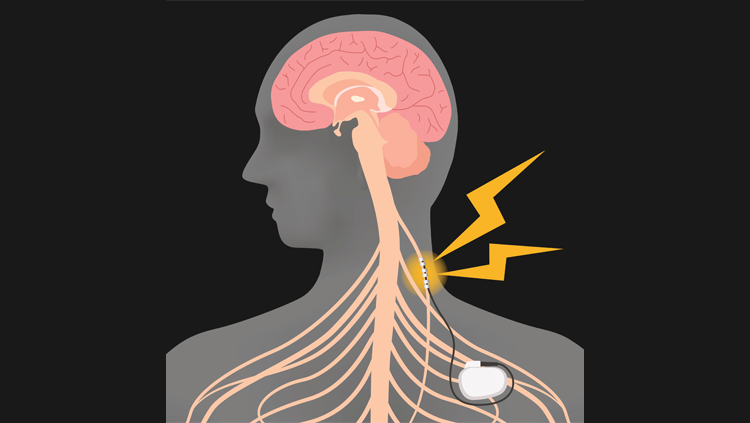Smoke Gets in Your Eyes — And Hurts Your Brain
- Published26 Dec 2018
- Reviewed26 Dec 2018
- Author Alexis Wnuk
- Source BrainFacts/SfN

I hardly noticed the smoke at first. By my second day in San Francisco, high noon could be mistaken for early morning as the sun produced an eerie, diffused glow, and all around me people donned facemasks and respirators. By the third day, a faint perfume of charred wood prevailed, and my eyes burned.
One hundred fifty miles to the north, the Camp Fire was tearing through the town of Paradise. It would become the deadliest wildfire in California’s history, claiming 88 lives, destroying nearly 14,000 homes, and consuming 153,000 acres — an area more than ten times the size of Manhattan. The fire blanketed the Bay Area in smoke, prompting officials to close schools and universities and cancel outdoor activities.
Breathing dirty air damages lungs: it can worsen asthma symptoms and increase the risk of developing lung cancer. What’s more, for decades there have been hints that breathing dirty air may also be bad for our brains.
The Canaries in the Coal Mine
A telling bit of evidence emerged in 2002, with a discovery that dogs living in a highly polluted region of Mexico City had inflamed brains. Scientists found that for these dogs the defense system normally blocking toxins in the blood from entering the brain had become leaky, allowing a direct route for harmful substances to reach the brain. Those dogs turned out to be canaries in a coal mine.
Two years later, the same researchers discovered air pollution also hurts the human brain. Led by Lilian Calderón-Garcidueñas, now at the University of Montana, the team found that lifelong residents of highly polluted cities harbored more markers for inflammation in their brains, particularly in parts of the brain involved in high-level thinking and memory such as the frontal cortex and hippocampus. What’s more, their brains were flecked with a protein called amyloid beta 42, a component of the toxic plaques that characterize Alzheimer’s disease.
At the time, levels of common airborne pollutants in Mexico City often exceeded guidelines set by the U.S. Environmental Protection Agency. The 1970 Clean Air Act authorized the EPA to regulate emissions from cars and power plants and set national standards for air quality. Since its passage, in the U.S., we’ve switched to cleaner cars, plants and factories spew fewer pollutants, and air quality has improved dramatically. But at a time when each new wildfire smashes previous records and darkens skies for hundreds of miles, has a new threat emerged?
Current environmental regulations may provide a false sense of security, says Jiu-Chiuan Chen, an epidemiologist at the University of Southern California. “There's an implicit assumption about a [regulatory] standard that is that everything below that [standard] is safe,” he says. But the evidence shows “that probably is not the case.” Chen has spent the last decade studying how air pollution compromises the brain and impairs memory, attention, and behavior.
A Particulate Problem
Air pollution is a complex mixture of gases, solid and liquid particles suspended in the air. Of the many noxious compounds that may threaten brain health, scientists have zeroed in on tiny particles called PM2.5.
Fewer than 2.5 micrometers in diameter, PM2.5 particles are 30 times smaller than the width of the average human hair. Its small size is what makes it so harmful: While the lungs trap large inhaled particles, PM2.5 particles are tiny enough to slip through the lungs and into the bloodstream.

PM2.5 is a product of combustion, whether it’s motor vehicle exhaust, power plants, residential wood burning, or wildfires, and it’s the main cause of haze and reduced visibility in the United States.
Michelle Block, a neuroscientist at the Indiana University School of Medicine, says many scientists were skeptical of the initial reports in dogs and people. The studies were small and there wasn’t enough epidemiological evidence linking air pollution and brain health to back them up, she says. “It took a long time for that to catch up.”
Now, two decades later, there is ample evidence. In 2009, Chen found chronic exposure to air pollution was linked to memory and attention problems in American adults.
In 2017, Chen and his USC colleagues reported that living in locations where ambient particulate matter exceeded EPA guidelines nearly doubled women’s risk of developing dementia and Alzheimer’s disease. To get at the potential mechanism of the increased risk, the researchers turned to mice. After breathing particulate-laden air for 15 weeks, toxic proteins accumulated in their brains, and neurons in a specific region of the hippocampus called CA1 withered.
The results surprised coauthor Caleb Finch, a gerontologist at USC. “It turns out those are the same neurons that are most vulnerable in Alzheimer’s,” Finch says. Air pollution may operate less like a hammer and more like a scalpel — selectively damaging the part of the brain involved in Alzheimer’s disease.
Children are also at risk. A 2008 study found Boston children exposed to higher levels of black carbon — a common type of particulate matter found in traffic exhaust — had lower IQs. And in 2011, researchers in California reported living near a freeway was associated with autism: mothers of autistic children were two times more likely to have lived near a freeway during the third trimester of pregnancy and after delivery, compared to mothers of normally-developing children.
Studies in mice offer a few clues about what’s going on in young brains exposed to air pollution. In 2014, researchers found male — but not female — mice exposed to fine particle pollutants earlier in life had larger ventricles, the fluid-filled cavities of the brain. Enlarged ventricles are a hallmark of autism and schizophrenia.
Finding a Mechanism
We are learning that breathing polluted air over a lifetime or during a sensitive window of development hurts the brain — but how?
In one of her early studies of Mexico City residents, Lilian Calderón-Garcidueñas suggested airborne pollutants might infiltrate the brain. Once inhaled, they could slip into the smell-sensing neurons in the nose and travel up to the olfactory bulbs, clusters of nerve cells located just behind the eyes.
Chen and other scientists are skeptical. So far, experiments demonstrating inhaled particles can be transported into the brain use engineered nanoparticles, Chen says. Whether we can extrapolate from engineered particles to the complex chemical cocktail of outdoor air pollution “remains an issue of great debate.”
And, pollutants may not need to get into the brain to wreak havoc there. Particles in the lungs or bloodstream might alert the immune system and trigger inflammation in the brain. If swallowed, they could perturb the gut microbiome, the ecosystem of microbes lining the gastrointestinal tract that mounting evidence suggests communicates with the brain.
“There’s a whole bunch of different ways air pollution could affect the brain,” Block says. And figuring all of them out is important if we want to change environmental regulations, she says.
Is Progress Burning?
Between 2000 and 2017, the average concentration of PM2.5 fell by 41 percent in the U.S. But, smoke from wildland fires are responsible for an increasingly large portion airborne particulate: The EPA now estimates 40 percent of particulate matter comes from wildland fires. And climate change is partly to blame: rising temperatures and more frequent and severe droughts are drying out the vegetation that fuels wildfires. The result is an extended fire season and wildfires that burn bigger, hotter, and longer.
“The bigger the size [of the fire], the more smoke you generate,” says Loretta Mickley, a climate scientist at Harvard University. In a 2016 study, Mickley and a team of researchers coined the term “smoke wave” to describe the polluted air generated by wildfires. The team predicted that more than 82 million Americans in western and Great Plains states will experience a 60 percent increase in smoke waves by 2050.
“This is an overlooked area of climate change,” Mickley says. “I think the U.S. EPA has done a terrific job of cleaning up air quality over the last 30 years. But climate change could really set us back,” she says. It could “throw a monkey wrench into these efforts to clean the air by bringing on increased wildfires and thus increased smoke.”
And more smoke could spell trouble for brains young and old. “Climate change is awful for what it does to the earth in general,” Block says, “but it also has terrible human health consequences.”
CONTENT PROVIDED BY
BrainFacts/SfN
References
Block, M. L., & Calderón-Garcidueñas, L. (2009). Air pollution: mechanisms of neuroinflammation and CNS disease. Trends in Neurosciences, 32(9), 506–516. doi:10.1016/j.tins.2009.05.009
Brockmeyer, S., & D’Angiulli, A. (2016). How air pollution alters brain development: the role of neuroinflammation. Translational Neuroscience, 7(1), 24–30. doi:10.1515/tnsci-2016-0005
Cacciottolo, M., Wang, X., Driscoll, I., Woodward, N., Saffari, A., Reyes, J., … Chen, J. C. (2017). Particulate air pollutants, APOE alleles and their contributions to cognitive impairment in older women and to amyloidogenesis in experimental models. Translational Psychiatry, 7(1), e1022. doi:https://doi.org/10.1038/tp.2016.280
Calderón-Garcidueñas, L., Azzarelli, B., Acuna, H., Garcia, R., Gambling, T. M., Osnaya, N., … Rewcastle, B. (2002). Air pollution and brain damage. Toxicologic Pathology, 30(3), 373–389. doi:10.1080/01926230252929954
Calderón-Garcidueñas, L., Reed, W., Maronpot, R. R., Henríquez-Roldán, C., Delgado-Chavez, R., Calderón-Garcidueñas, A., … Swenberg, J. A. (2004). Brain inflammation and Alzheimer’s-like pathology in individuals exposed to severe air pollution. Toxicologic Pathology, 32(6), 650–658. doi:10.1080/01926230490520232
Calderón-Garcidueñas, L., Solt, A. C., Henríquez-Roldán, C., Torres-Jardón, R., Nuse, B., Herritt, L., … Reed, W. (2008). Long-term air pollution exposure is associated with neuroinflammation, an altered innate immune response, disruption of the blood-brain barrier, ultrafine particulate deposition, and accumulation of amyloid beta-42 and alpha-synuclein in children and young adults. Toxicologic Pathology, 36(2), 289–310. doi:10.1177/0192623307313011
Cascio, W. E. (2018). Wildland fire smoke and human health. The Science of the Total Environment, 624, 586–595. doi:https://doi.org/10.1016/j.scitotenv.2017.12.086
Chen, J.-C., & Schwartz, J. (2009). Neurobehavioral effects of ambient air pollution on cognitive performance in US adults. Neurotoxicology, 30(2), 231–239. doi:https://doi.org/10.1016/j.neuro.2008.12.011
Chen, J.-C., Wang, X., Wellenius, G. A., Serre, M. L., Driscoll, I., Casanova, R., … Espeland, M. A. (2015). Ambient air pollution and neurotoxicity on brain structure: Evidence from women’s health initiative memory study. Annals of Neurology, 78(3), 466–476. doi:https://doi.org/10.1002/ana.24460
D’Angiulli, A. (2018). Severe Urban Outdoor Air Pollution and Children’s Structural and Functional Brain Development, From Evidence to Precautionary Strategic Action. Frontiers in Public Health, 6. doi:https://doi.org/10.3389/fpubh.2018.00095
Liu, J. C., Mickley, L. J., Sulprizio, M. P., Dominici, F., Yue, X., Ebisu, K., … Bell, M. L. (2016). Particulate air pollution from wildfires in the Western US under climate change. Climatic Change, 138(3–4), 655–666. doi:10.1007/s10584-016-1762-6
Mooney, C. (2017, December 15). Smoke from wildfires may be surprisingly deadly, scientists report - The Washington Post. The Washington Post. Retrieved from https://www.washingtonpost.com/news/energy-environment/wp/2017/12/15/smoke-from-wildfires-may-be-surprisingly-deadly-scientists-report/?utm_term=.a605f17d9907
Ranft, U., Schikowski, T., Sugiri, D., Krutmann, J., & Krämer, U. (2009). Long-term exposure to traffic-related particulate matter impairs cognitive function in the elderly. Environmental Research, 109(8), 1004–1011. doi:10.1016/j.envres.2009.08.003
Suglia, S. F., Gryparis, A., Wright, R. O., Schwartz, J., & Wright, R. J. (2008). Association of black carbon with cognition among children in a prospective birth cohort study. American Journal of Epidemiology, 167(3), 280–286. doi:10.1093/aje/kwm308
Underwood, E. (2017, January 26). The Polluted Brain: Evidence builds that dirty air causes Alzheimer’s, dementia. Science. Retrieved from http://www.sciencemag.org/news/2017/01/brain-pollution-evidence-builds-dirty-air-causes-alzheimer-s-dementia
US EPA, O. (2018, January 26). The Danger of Wildland Fire Smoke to Public Health [Overviews and Factsheets]. Retrieved August 23, 2018, from https://www.epa.gov/sciencematters/danger-wildland-fire-smoke-public-health
Volk, H. E., Hertz-Picciotto, I., Delwiche, L., Lurmann, F., & McConnell, R. (2011). Residential Proximity to Freeways and Autism in the CHARGE Study. Environmental Health Perspectives, 119(6), 873–877. doi:https://doi.org/10.1289/ehp.1307984
Woodward, N. C., Pakbin, P., Saffari, A., Shirmohammadi, F., Haghani, A., Sioutas, C., … Finch, C. E. (2017). Traffic-related air pollution impact on mouse brain accelerates myelin and neuritic aging changes with specificity for CA1 neurons. Neurobiology of Aging, 53, 48–58. doi:10.1016/j.neurobiolaging.2017.01.007



















